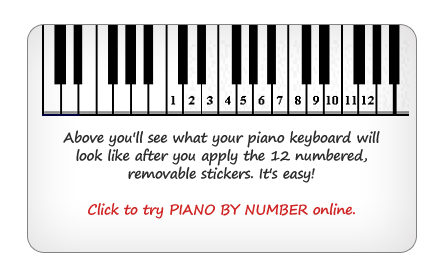Let's Play Piano With Our Eyes Closed

I often say to kids, “Let’s play piano with our eyes closed!” It’s a crazy game that yields amazing results and forces the child to make a mental picture. “Where did it go up, where did it go down, oh, yeah, here comes the hard part where I have to slide the thumb under.”
Be sure to tailor the passage to the child, and make it easy enough for them to get the hang of “making a mental picture.” This may be the first time a child is asked to do such a thing. Many kids, especially the youngest, have never tried to imagine the complexities that an adult deals with every day.
Piano Is Easy
If necessary, make the task to play a very simple pattern with the eyes closed. For example, thumb, index, middle finger of the right hand. 123.
This will at least start the mental process of forming images of the piano keyboard.
Kids Have To Imagine The Keyboard
The reason for this game is that there is a huge difference between playing the piano, and reading music. You don’t have to necessarily read a piece of music to be able to play it at the piano. All that is required is an understanding of the geography of the piano keyboard, and a knowledge of chords. That is why blind people can play the piano.
Pros Look At The Keys
Professional pianists perform at the piano with eyes on the keys, not a page of sheet music. Any pianist who plays with the music in front of them is either practicing, sight reading, or accompanying, but they are not playing memorized music that comes from themselves. You can’t be lost in the thrill of a drive with your eyes glued to the map. That’s all sheet music is, a map.
The Page Is Too Abstract For The Child
Children only understand the music they are actually able to make at the piano. They have no concept of your abstract idea of what they ought to be able to play. Asking them for more than they can actually play comfortably will instantly frustrate them.
You have to carefully plan how to support them in this uncharted territory. The evidence for this is that all children, regardless of age, are able to play, by eye and ear, music far more complicated than they may ever be able to read as sheet music.
Try A Song With Numbers
Kids Are Visual, Not Abstract
What does this mean? It means that children learn the piano visually best at first, saving notes for later when they understand many of the complex elements involved, such as timing, fingering and chords. I have child students who can play their own version of FLIGHT OF THE BUMBLEBEE at age 8, when they cannot even begin to decipher the notes.
Why? Children find the patterns interesting. They do not find the same patterns, expressed as notes on a page, in any way interesting. They find notes confusing. Piano keys are finite, a thing they can touch. Music notes are way up there on the page, unreachable.
Just Like A Video Game
As with video games, children at the piano become fascinated with this matrix of visual and aural information. The piano has the added attraction of producing beautiful sounds just as video games produce pleasing actions. It is from this self-engendered enthusiasm that child pianists are born, not from any method or regime or teacher. You have to love it or it’s worthless.
You Can’t Look At The Page And The Keys
When you insist the child look at the page all the time, you rob them of the one tool they can rely on: their eyes. In conventional lessons their eyes are glued to the page. This prevents the child seeing the visual patterns right in front of them on the keyboard. The obvious solution is to reverse the process. Put the musical information visually on the keyboard first.
Later, introduce the sheet music. You say something like, “The thumb starts here, and then you play four notes up, to the right, using every finger.” Simple visual language like this excites kids, because it is something they can grasp right away. Reading music, on the other hand, is like asking children to quickly appreciate rustic German poetry in the original dialect. It isn’t going to happen unless, perhaps, you are a rustic German child.
The “rule” is to help the child play familiar songs at first, under any means. Then, slowly attempt to start reading music and begin refining that skill. Reversing the order of the above “rule” (read first, play later) is a disaster for 90% of child piano students. If your motto is, “Play a lot, then work a little,” a child will follow you anywhere. Get them to play at first, not read.
BOOKS FOR YOUNGER KIDS
REFERENCES
Games
Turn Your Piano Into A Toy
Follow The Leader Visual Piano Games
Happy or Sad? Ear Training for Kids
The Piano Dice Game
Piano Hand Position Games
Chordomatic Piano Game
Piano Fun & Games!
Piano Practice Games
How To Create Piano Games for Kids
Let’s Play Piano With Our Eyes Closed
Piano Blues Game
The Future Effect Of Piano Games
Visual Piano Games and Exercises
Baseball Piano Game
Quarters Piano Game
Mozart’s Favorite Movie
The Impossible Kid’s Piano Game
12 Bar Blues
Piano Activities Kids Find Comfortable
Baseball Piano Chord Game
Precursor Skill Piano Games
Piano Games for Kids





